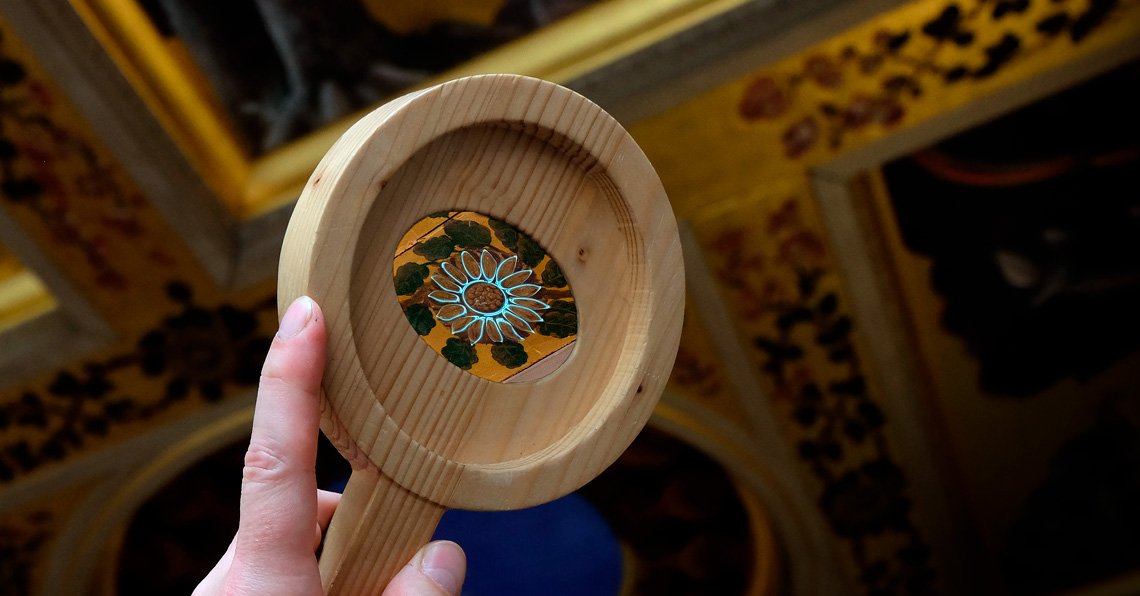How was it made? The Loupe
Issue: XXVI.6 November - December 2019Page: 14
Digital Citation
Authors:
Dick van Dijk
Describe what you made. We developed a tool for museum visitors that provides access to multiple layers of information: an interactive magnifying glass. The Loupe prompts users to search for objects by displaying their outline on a concealed phone display. If the visitor matches the outline of the object with the right physical object, relevant content is displayed. The object's outline is pre-programmed (a transparent PNG image). The phone runs an AR application, developed with the Vuforia AR software development kit, that connects the physical realm with the digital content and overlays.
 |
Exploring a mockup of the monocular concept in co-creation with heritage professionals. |
Briefly describe the process of how this was made. The Loupe was imagined in a co-creation workshop with museum professionals. Conceptually, the Loupe started out as a magic monocular that would reveal AR content inside an exhibition space. The idea was acted out using a mock-up made of a sheet of round glass with some drawings on it. The participants judged that "making the invisible visible" was promising, but the monocular idea was discarded, as it would isolate someone from the social context of a museum visit.
We wanted to make use of the user's "natural" behavior, so we enclosed a smartphone in a wooden casing. This allowed us to use the embedded sensors of the phone. We opted for a firm casing to allow visitors to more freely use the Loupe inside the museum. In the second iteration of the prototype, we added a pattern of small holes in the backplate of the casing to allow the phone to better vent the heat it produces. And we added a 3D-printed trigger inside to more easily release the phone from the casing (to allow charging or periodic updates).
 |
Brainstorming interaction ideas around a specific collection item (a mummy), including the Loupe. |
What for you is the most important/interesting thing about what you made? The format of the magnifying glass invokes a metaphor and cultural form that evokes how to use the device. The form also implies that multiple people may look through it, and that it can be handed over (unlike a phone, it is not a personal device). The metaphor intuitively instills in visitors an active, look-for rather than listen-to attitude, and changes their behavior from looking at an object to exploring or actively researching an object.
 |
Storyboarding potential content items related to the mummy. |
Was this a collaborative process, and if so, who was involved? The Loupe was prototyped by Waag with museum partners as part of the EU-funded meSch project. We tested the Loupe with museum visitors in different contexts and with different content in the Allard Pierson Museum (Netherlands), the Hunt Museum (Ireland), and the History Museum in Sofia (Bulgaria).
 |
Milling the front cover of the Loupe on a milling machine. |
What was the biggest surprise in making this? One of the key requirements of the Allard Pierson Museum was to create a prototype that would allow fast and easy in-house content creation and updates. We therefore focused on creating an editorial system that allowed for media that is familiar to museum curators: using simple media, such as text, and simple 2D images and sounds instead of rich 3D visuals. In prototyping the content, it surprised the museum curators that almost all of their existing content consisted of long academic texts rather than accessible texts and visuals.
 |
Isolated back plate of the Loupe with bespoke screw tool to open and close the Loupe. |
 |
3D printing the handle inside the Loupe. |
Dick van Dijk, Waag, Amsterdam, [email protected]
Copyright held by author
The Digital Library is published by the Association for Computing Machinery. Copyright © 2019 ACM, Inc.



